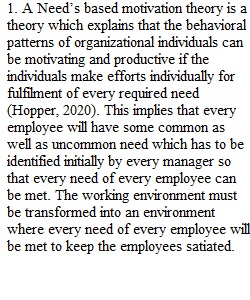


Q Per the instructions/grading rubric in the syllabus, you must post one (1) original response to ONE (1) of the QUESTION SETS below, and then respond to one (1) classmate by the deadline in the Course Schedule. Remember, a total of TWO (2) posts are required. NOTE: You must post before seeing classmates' replies Keep in mind that full credit is NOT guaranteed per the grading rubric in the syllabus. Students will lose credit for excessive spelling and/or grammatical errors, lack of understanding/knowledge of the material, and/or lack of independence of thought. Please proof your work (no texting language or abbreviations such as "agro" for "aggravated/hostile" – use proper grammar!) and give credit to any works referenced (Use the APA format). Questions for Discussion: 1. Answer the following questions by referencing CH 7 and the supporting video on Maslow's Hierarchy of Needs o What is a Need's based motivation theory and what are the needs in Maslow's Theory? o Give an example of a lower order need and a higher order need. o How do the needs in Maslow's theory relate to each other? Which needs must be fulfilled for a higher order need to be the primary motivator? Why? OR 1. Answer the following questions by referencing CH 8 and the supporting video on "When paying doesn't pay off - A movie on incentives." o Briefly explain the difference between an intrinsic and an extrinsic motivator or incentive. Provide an example of each. o What type of incentive is more likely to drive long-term behavior? Why? o Monetized incentives can have the opposite effect then intended? Why? Provide an example.
View Related Questions